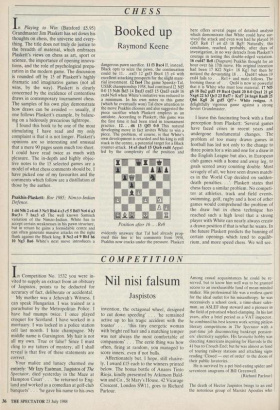CHESS
In Playing to Win (Batsford £5.95)
Grandmaster Jim Plaskett has set down his thoughts on chess, the universe and every- thing. The title does not truly do justice to the breadth of material, which embraces Plaskett's views on chess as art, sport or science, the importance of opening innova- tions, and the role of psychological prepa- ration in the modern game. The discussion is rounded off by 15 of Plaskett's highly dramatic and imaginative games (not all wins, by the way). Plaskett is clearly concerned by the incidence of contentless draws in contemporary tournament chess. The samples of his own play demonstrate how draws can be avoided — usually, if one follows Plaskett's example, by balanc- ing on a hideously precarious tightrope.
I found this book to be one of the most stimulating I have read and my only
complaint is that it is not longer. Plaskett's opinions are so interesting and unusual that a mere 90 pages seem much too short.
I could have read twice as much with pleasure. The in-depth and highly objec- tive notes to the 15 selected games are a model of what chess comments should be. I
have picked one of my favourites and the comments which follow are a distillation of those by the author.
Psakhis-Plaskett: Bor 1985; Nimzo-Indian Defence.
1 d4 Nf6 2 c4 e6 3 Nc3 BM 4 e3 c5 5 Bd3 Nc6 6 a3 Bxc3+ 7 bxc3 e5 The well known Samisch variation of the Nimzo-Indian. White has to accept certain weaknesses in his pawn structure, but in return he gains a formidable centre and can often generate massive attacks on the right flank against the Black king. 8 Net e4 9 Bbl b6 10 Ng3 Ba6 White's next move introduces a
Booked up
Raymond Keene
dangerous pawn sacrifice. 11 f3 Bxc4 If, instead, Black opts to seize the pawn, the continuation could be 11. . .exf3 12 gxf3 Bxc4 13 e4 with excellent attacking prospects for the slight mate- rial investment. 12 fxe4 The game Spassky-Tal, USSR championship 1958, had continued12 Nf5 0-0 13 Nd6 Bd3 14 Bxd3 exd3 15 Qxd3 exd4 16 cxd4 Ne8 when White's initiative was reduced to a minimum. In his own notes to this game (which he eventually won) Tal drew attention to the move Psakhis chooses and also suggested the piece sacrifice which Plaskett employs as an antidote. According to Plaskett, this game was the first time it had been tried in tournament practice. 12. . . d6 13 Qf3 0-0 This natural developing move in fact invites White to win a piece. The problem, of course, is that White's own development is retarded and his king is still stuck in the centre, a potential target for a Black counter-attack. 14 e5 dxe5 15 Qxc6 exd4 Appal- led by the complexity of the position and Position after 16 . Re8 evidently unaware that Tal had already prop- osed this line it, his comments from 1958, Psakhis now cracks under the pressure. Plaskett
here offers several pages of detailed analysis which demonstrate that White could have sur- vived the attack and even won had he played 16 Qf3! Re8 17 e4 d3 18 Bg5! Naturally, this conclusion, reached, probably, after days of investigation, in no way detracts from Plaskett's courage in testing this double-edged variation. 16 cxd4? Re8 (Diagram) Psakhis thought for an hour over his 17th move. His original intention had been 17 Kf2 Ng4+ 18 Kgl but then he noticed the devastating 18 . . Qxd4!! when 19 exd4 fails to . . . Rel + and mate follows. The looming threat of . . . Qxd4 is now so powerful that it is White who must lose material. 17 Nf5 g6 18 Bat gxf5 19 Bxc4 Qxd4 20 0-0 Qxal 21 g4 Nxg4 22 h3 Qc3 23 Bxf7+ Kxf7 24 hxg4 Rad8 25 Qh6 KgS 26 gxf5 Qf7+ White resigns. A delightfully vigorous game against a strong Soviet Grandmaster.
I leave this fascinating book with a final perception from Plaskett: 'Several games have faced crises in recent years and undergone fundamental changes. The problem of too many drawn games in football has led not only to the change to
three points for a win and one for a draw in the English League but also, in European club games with a home and away leg, to goals scored away counting double. Most savagely of all, we have seen drawn match- es in the World Cup decided on sudden- death penalties. . .'. Plaskett states that chess faces a similar problem. No competi- tor at athletics, track and field events, swimming, golf, rugby and a host of other games would comprehend the problem of the draw but in chess technique has
reached such a high level that a strong player with White can nearly always create a drawn position if that is what he wants. In the future Plaskett predicts the banning of
certain openings which tend to equilib- rium, and more speed chess. We will see.














































 Previous page
Previous page